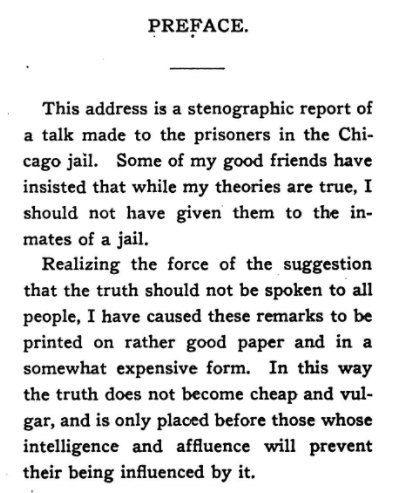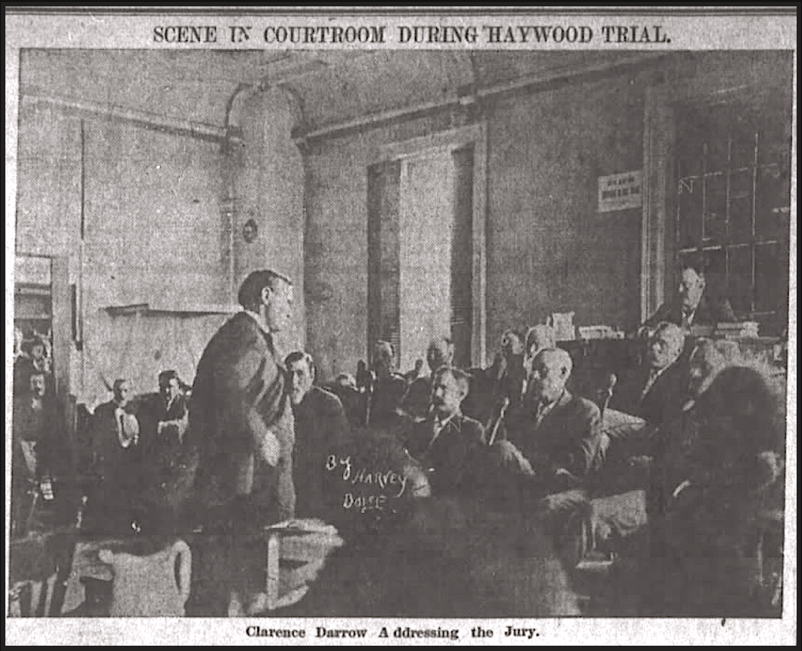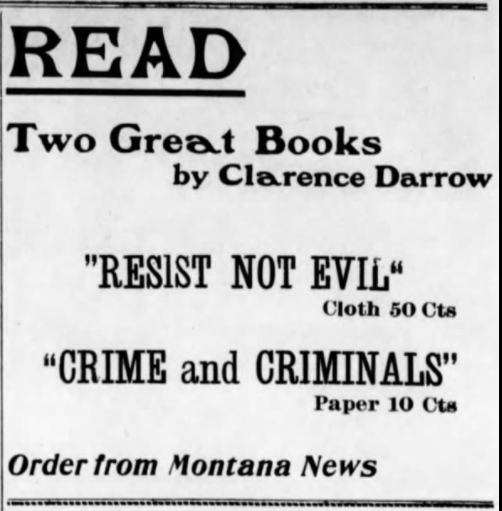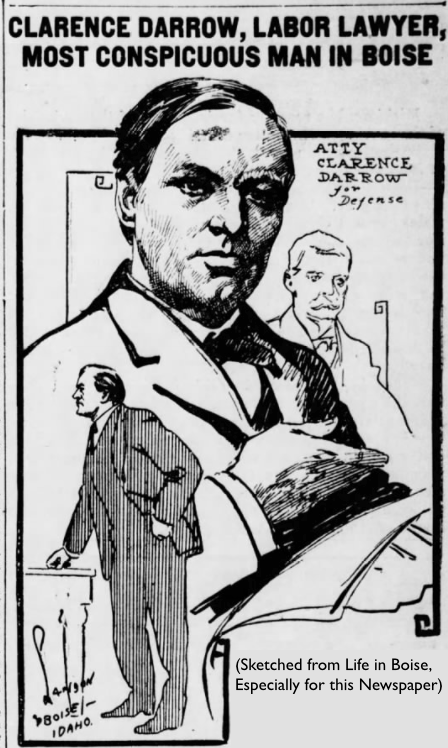True patriotism hates injustice
in its own land
more than anywhere else.
-Clarence Darrow
Hellraisers Journal, Thursday September 26, 1907
A Tribute to Clarence Darrow, Hero of Many Battles For Labor
From the Duluth Labor World of September 21, 1907:
CHARACTER SKETCH OF CLARENCE S. DARROW
—–
Great Lawyer Who Defended Haywood
Fought Many Battles For Labor.
—–
He has Ever Been On the Firing Line
In the Interest of Humanity.
—–
—–
Twelve years ago, when Eugene V. Debs was imprisoned as a result of his activities in the great railway strike in Chicago, Clarence Darrow became his legal champion. Three years later he defended Thomas I. Kidd and two striking woodworkers who were charged with having “conspired,” through their union, “to injure the business” of a great lumber company in Oshkosh, Wis. His arguments, which has been printed in phamphlet form and is pronounced by no less a critic than William Dean Howells “as interesting as a novel” resulted in the acquittal of his clients.
A more distinctive figure than Darrow’s, says Kellogg Durland, in the Boston Transcript, has seldom come out of the west:
He was born in the Western Reserve of Ohio. His father was an honest man. After qualifying for the church he gave up the cloth for a country store that he might “feel surer of what he was doing.” At 19 young Darrow was teaching school. One year of college life satisfied him. Early in his twenties he drifted to Chicago and studied law. All his life he has been a dreamer and happy in his dreams. He has the strength of a man of vision. As a lawyer he has wide reputation, for he has been the corporation counsel for a great railroad and the defender of men like Eugene V. Debs and Kidd in the famous woodworkers’ conspiracy case. Public life has always called him, but he has mostly been deaf to the call. “I want to make my living as a lawyer and devote my leisure to writing stories and essays,” he has pleaded almost peevishly. “And I want to write a long novel.”
His life is best understood in his philosophy. The ideas he gives utterance to today are rooted in years of his boyhood when his plaint mind was brought in contact with scenes surrounding an underground railroad station. His flesh and blood heroes were Garrison, Kelley, Foster, Pillsbury and other devoted abolitionists who inspired him with ideals of liberty and fired him with bitter hatred toward every form of oppression. The black man’s fetters have been loosed, but he believes there are workingmen in this country who are shackled as truly as were ever the negroes. Darrow offers his life to these, if he sometimes speaks life a hater of the rich it is only because of his burning zeal to speak at all He calls himself a Tolstoyan. “Tolstoy,” he says, “is the first author who has put the doctrine of non-resistance on a substantial basis.” Tolstoy !s the one man to whom Darrow has ever pledged himself. To be sure, it is Rarrowesque [Darrowesque?] Tolstoyanism, but it works out an interesting code and Darrow follows it with amazing consistency. He has ever steadfastly refrained from committing himself to any movement which partook of the nature of an ism.
It was in 1888 that Chicago first began to ask, “Who is this man Darrow?” He had delivered a speech in the Central Music Hall on labor and taxation, and Henry George had spoken on the same occasion from the same platform. Among those who were deeply impressed by this speech was ex-Governor Altgeld, and later he and Darrow went into partnership. “Altgeld was the first man of importance to express any recognition of the fact that there lives a man of the name of Clarence S. Darrow,” Darrow once remarked. Altgeld believed that in Clarence Darrow was the making of a man of destiny. Several years after the partnership had been formed Darrow went into politics for awhile and was elected to the state legislature. Some of his friends wanted to nominate him for mayor of Chicago. But he balked. “The people don’t want me in the mayor’s chair,” he told them. “I am too radical.” Mr. Rutland [Durland] proceeds with his narrative:
Indifferent to personal appearances and conventional trifles of life, he ponders and emphasizes the larger issues. He is a brilliant speaker, quick at retort, incisive, epigrammatic. Six days in the week he gives over to the routine of business, but on Sundays he tucks loose pages of a favorite lecture into an outer coat pocket and scurries off to some obscure place to preach Tolstoy from the platform of any church that will open its doors to him, or to tell of the rich and deep humanity of Robert Burns at a single tax gathering or at an ethical league. Wherever men and women will listen to his utterances on the inherent worth of every human soul, there he will go. I have heard him talk until long past midnight to a handful of Jews in an upper room of the Chicago Ghetto. I have sat with a hundred radical Socialists, Anarchists and political and social outcasts for two hours and a half when he told the story of Waslova as drawn in “Resurrection,” but as usual, with as much of Darrow as of Tolstoy. I have sat with half a dozen friends through the evening and the night till 4 in the morning listening to him reading “Bonnie Brier Bush” tales which were as real to him and to us as reading from life.
—–
Darrow’s life, is an epitome of his theories; and his theories he has expounded in pamphlets and books which are unique in the literature of our time. The best of his books is entitled “A Persian Pearl, and Other Essays,” and in it he discusses, with a poet’s style and real insight, Omar Khayyam, Walt Whitman, Robert Burns, “Realism in Literature and Art” and “The Skeleton in the Closet.” The “Skeleton in the Closet” is a favorite phrase of Darrow’s symbolizing the secret in almost every life which enables us to understand the frailty and suffering of others. A second of Darrow’s books, “An Eye for to Eye,” communicates the psychology of a murderer in such a way as to make one feel, for the time being at least, the injustice of capital punishment. A third argument, devoted to the advocacy of Tolstoy’s doctrine of non-resistance, is entitled “Resist Not Evil.”
The most startling and revolutionary of Darrow’s utterances is embodied in a lecture on “Crime and Criminals,” delivered before the prisoners in Chicago county jail and is issued in a pamphlet. “There is no such thing,” says Darrow in his address, “as a crime as the word is generally understood. I do not believe there is any sort of distinction between the real moral condition of the people in and out of jail.” He adds: “In one sense everybody is equally good and equally bad. We all do the best we can under the circumstances.” Then follows the argument: “There is only one way to cure so-called crime, and that is to give the people a chance to live. There is no other way, and there never was and other way since the world began.”
There is a touch of pessimism in Darrow’s philosophy, and in “Farmington,” a story which is practically his autobiography, he voices, that sense of failure which comes to most of us at one time or another.
[He concludes:]
“All my life I have been planning and hoping and thinking and dreaming and loitering and waiting. All my life I have been getting ready to begin to do something worth while. I have been waiting for the summer and waiting for the fall; I have been waiting for the winter and waiting for the spring; waiting for the night and waiting for the morning; waiting and dawdling and dreaming, until the day is almost spent and the twilight close at hand.
In one sense, however, this is only the humility of an idealist. For Darrow has already accomplished a great deal along the lines he has chosen.
———-
[Photographs added.]

SOURCE
The Labor World
(Duluth, Minnesota)
-Sept 21, 1907
http://chroniclingamerica.loc.gov/lccn/sn78000395/1907-09-21/ed-1/seq-2/
IMAGES
HMP, Darrow Addresses the Jury, OR Dly Jr, June 29, 1907
https://www.newspapers.com/image/79663289
Clarence Darrow, Ad for books, MT Ns, Sept 5, 1907
http://chroniclingamerica.loc.gov/lccn/sn84024811/1907-09-05/ed-1/seq-2/
HMP, Darrow by Landon, Stt Str, May 14, 1907
https://www.newspapers.com/image/201689137/
Expensive Form Truth, Clarence Darrow
https://archive.org/stream/2917177.0001.001.umich.edu#page/2/mode/2up
See also:
A Persian Pearl: And Other Essays
-by Clarence Darrow
Roycroft Shop, 1899
https://books.google.com/books?id=MXQ_AAAAYAAJ
An Eye for an Eye
-by Clarence Darrow
NY, 1905
https://books.google.com/books?id=P106AQAAMAAJ
Resist Not Evil
-by Clarence Darrow
C. H. Kerr, 1903
https://books.google.com/books?id=I09YAAAAMAAJ
Crime and Criminals
-by Clarence S Darrow
(First pub’d by Kerr in 1902.)
CH Kerr, 1910
https://archive.org/stream/2917177.0001.001.umich.edu#page/n1/mode/2up
Note: In trying to determine when, exactly, Darrow spoke to the prisoners at the Cook County Jail, this is the closest that I could come (more research needed):
Attorney for the Damned:
Clarence Darrow in the Courtroom
-ed by Arthur Weinberg
University of Chicago Press, Oct 12, 2012
(search: “cook county jail” 1902)
https://books.google.com/books?id=2DULr17KAl8C
Farmington
-by Clarence S. Darrow
Chicago, 1904
https://archive.org/stream/farmington00darrrich#page/n5/mode/2up
The Painter and Decorator, Volume 21
(LaFayette, Indiana)
Jan-Dec 1907
Brotherhood of Painters, Decorators and Paperhangers of America, 1907
https://books.google.com/books?id=YNufAAAAMAAJ
P&D Aug 1907
https://play.google.com/books/reader?id=YNufAAAAMAAJ&printsec=frontcover&output=reader&hl=en&pg=GBS.PA453
“Who Is This Man Darrow?”
(This is the same article as above, but with different title.)
https://play.google.com/books/reader?id=YNufAAAAMAAJ&printsec=frontcover&output=reader&hl=en&pg=GBS.PA457
Note: preceding “Who Is This Man Darrow,” we find a story: “The Home of Jane Lewis,” which appears to be authored by Clarence Darrow. At the end of the story we find: “-Clarence Darrow.”
https://play.google.com/books/reader?id=YNufAAAAMAAJ&printsec=frontcover&output=reader&hl=en&pg=GBS.PA454



